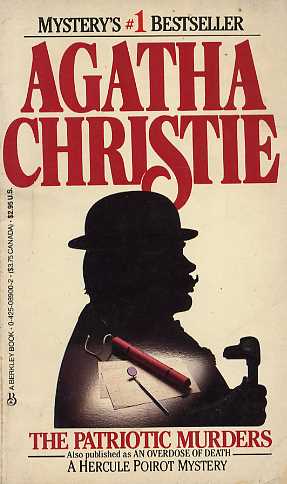

The significance of the shoe buckle in the first part of the rhyme is strong and immediate, but from then on, the rhyme gets progressively weaker and more irrelevant in its association. However, I’m not entirely satisfied that the association works that well. But it’s in this book that the association with the rhyme is tied in most strongly, as the ten chapters are named after the various lines of the rhyme. Just like And then there were none, A Pocket Full of Rye, Five Little Pigs and Hickory Dickory Dock, Christie named this book after a nursery rhyme. The original American title, The Patriotic Murders, both helps and hinders the reader with the motive for the crimes committed within its covers. It’s definitely a book of its time, with a number of references and influences relating to the political turmoil at the beginning of the Second World War. It’s an enjoyable book, but a highly complex crime, and it takes a lot of concentration for the reader to really get to grips with what’s going on, and not just rely on Poirot to do the work for you. However, I had completely forgotten by whom, and what the whole story was about, so it was very enjoyable to get re-acquainted with it. When I started to re-read this book, I instantly remembered the dental surgery scene and that a murder would be committed there. But I understand that today it is usually known as One, Two, Buckle my Shoe in the US as well. A later American edition in 1953 republished the book under the title An Overdose of Death.

The full book was first published in the UK in November 1940 by Collins Crime Club and then subsequently in the US by Dodd, Mead & Co in February 1941, still as The Patriotic Murders. Interestingly, and unusually, it does not appear to have been previously serialised in the UK.

One, Two, Buckle my Shoe was first serialised in the US in Colliers’ Weekly in August and September 1940, under the title The Patriotic Murders. And presumably you couldn’t get your hands on cream during the war. North’s daughter, Susan and Christie’s daughter, Rosalind, were best friends in their 20s, and in fact it was Dorothy who presented the eighteen-year-old Rosalind at Court as Christie was had been divorced, she was not entitled to have the honour herself. The book is dedicated to “Dorothy North who likes detective stories and cream, in the hope it may make up to her for the absence of the latter.” Dorothy North, daughter-in-law to the 12th Baron North, was a close member of Christie’s London social circle in the 1930s. Inspector Japp invites him in to help discover what really happened, and soon Poirot is immersed in a web of political intrigue and activists – but is it a crime of passion or of politics? As usual, if you haven’t read the book yet, don’t worry, I promise not to tell you whodunit! In which Hercule Poirot unwillingly attends an appointment at the dentists, only to find out that a murder takes place at the dental surgery later on the same day.


 0 kommentar(er)
0 kommentar(er)
